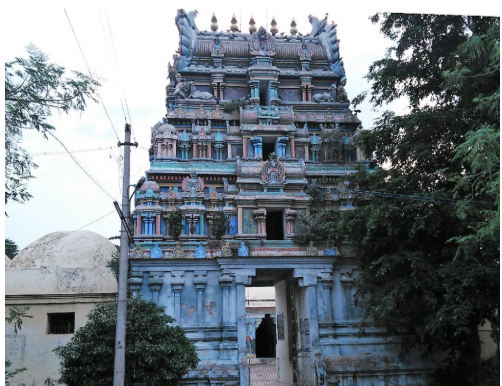Origin/History :-
The temple has a rich history, existing since at least the 7th century, when Saint Sambandar worshipped here. According to the inscriptions within the temple, it was built by Kulothunga Chola I in the late 11th or early 12th century. The inscriptions also mention grants from various kings, including Sadayavarman Sundara Chola Pandyan. Notably, the temple features two altars: one located behind Nandi and the other in front of it. The main sanctum is situated in the bat-nethi hall.
Puranic Significance :-
- Legend of Airavatam
Airavatam is the elephant vehicle of Lord Indra, characterised by its white skin and four tusks. Sage Durvasa once brought a lotus flower that adorned the Shivalingam consecrated by him at Kasi and presented it to Lord Indra during a ceremonial procession. However, Indra, showing arrogance, received the flower with one hand and placed it on Airavatam’s head. In response, the elephant rejected the disrespectful act by using its trunk to throw the flower on the ground and stamped on it. Angered by this, Sage Durvasa cursed both Indra and Airavatam, resulting in Airavatam becoming a wild elephant. For a hundred years, it wandered to several holy places, worshipping deities before regaining its original form in Madurai. This story is narrated in the Tiruvilayadal Puranam, and Tirukkottaaru is one of the holy places where Airavatam is worshipped as a wild elephant.
- Subha Maharishi's Devotion
Subha Maharishi dedicated himself to worshipping Shiva daily. One day, when he arrived late and found the temple doors closed, he transformed into a bee to enter the sanctum and worship the Lord. After this incident, Subha Maharishi remained in the form of a bee, and a beehive has since thrived in the sanctum of the Prime Deity. Devotees are advised to keep their distance from the hive while offering prayers. Annually, honey is extracted from the hive and used to adorn the Lord, allowing the hive to flourish again. An image of Subha Maharishi can be seen on the rear side of the outer round.
- Establishment of the Lingam
It is believed that both Sage Agasthiyar and Subha Maharishi established the imposing Lingam at this location. The site has been a place of worship for many renowned sages, including Agasthiyar.
- Significance of Kóttaaru
The place is called ‘Kóttaaru’ as it is located on the banks of the Vanchiyaru River. The name reflects the legend of Airavatam, who worshipped the deity after striking the clouds and causing waters to flow down like a river.
